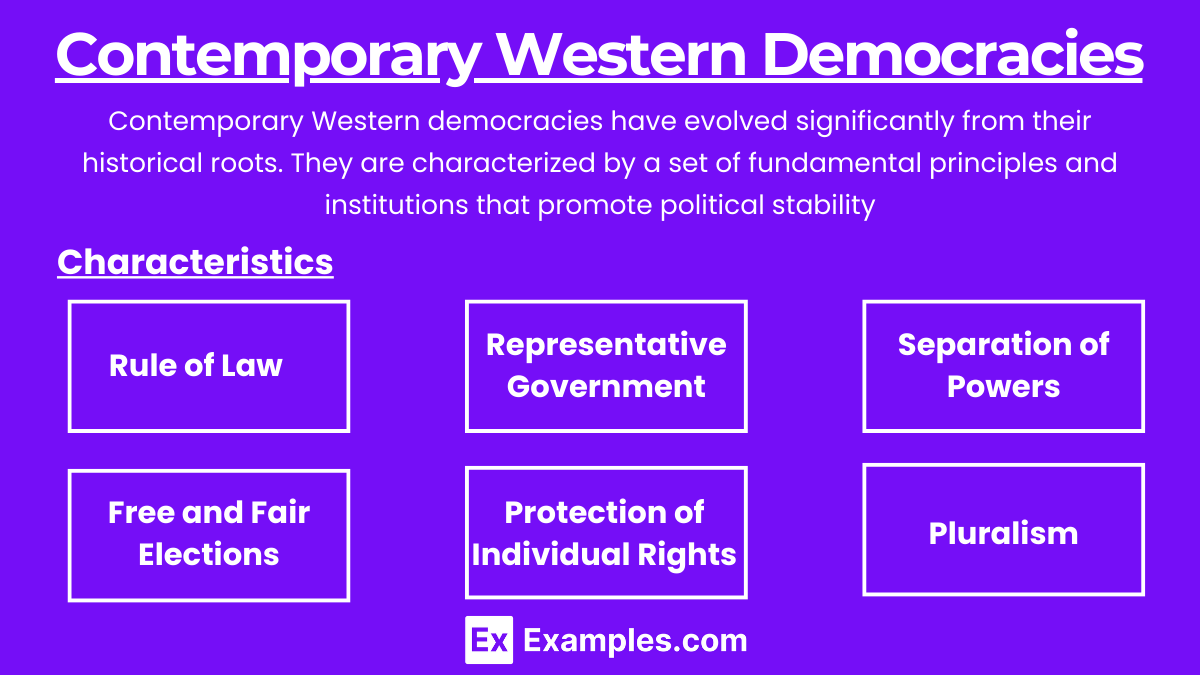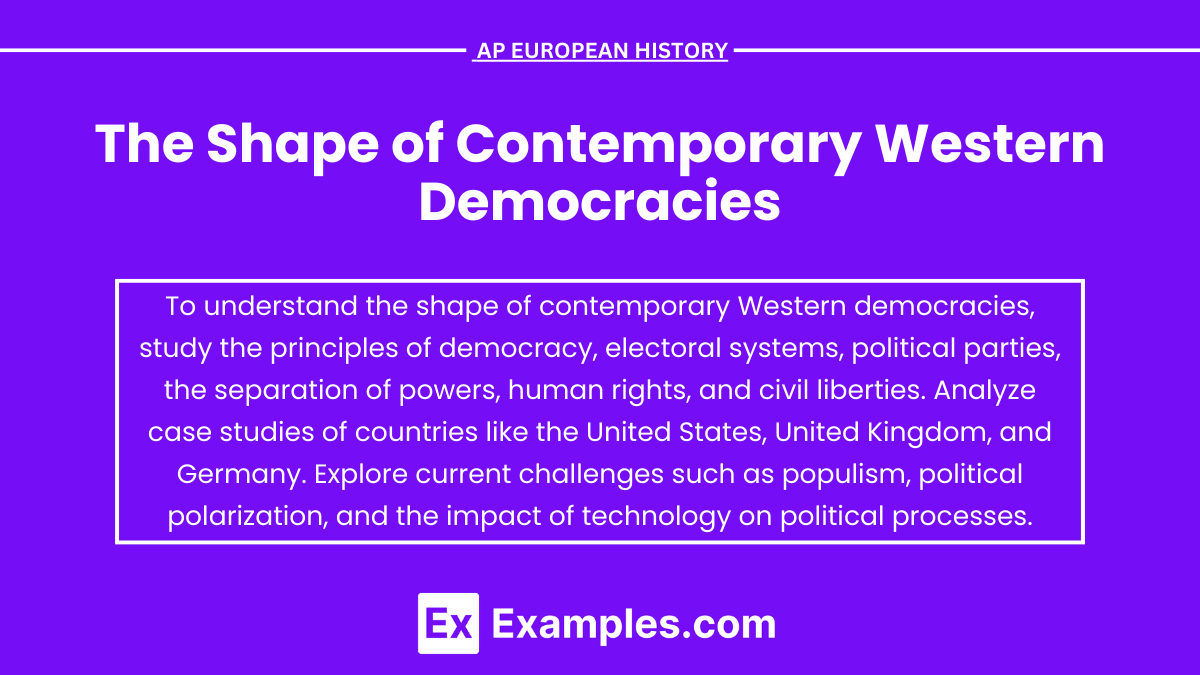Contemporary Western democracies have evolved into intricate systems characterized by rule of law, representative government, and protection of individual rights. These democracies are built on principles like the separation of powers, free and fair elections, and pluralism. Understanding these elements is crucial for students preparing for the AP European History exam, as it provides insight into the political and social frameworks that shape modern governance. Despite facing challenges such as populism and political polarization, Western democracies continue to adapt and uphold democratic values.
Learning Objectives
In studying “The Shape of Contemporary Western Democracies” for the AP European History exam, you should aim to understand the fundamental principles and institutions that define modern Western democracies, including the rule of law, representative government, and the separation of powers. Recognize the importance of free and fair elections, individual rights, and pluralism. Additionally, examine the challenges facing these democracies, such as populism, economic inequality, political polarization, technological change, and globalization, to comprehend their impact on democratic stability and governance.
Contemporary Western Democracies

Contemporary Western democracies have evolved significantly from their historical roots. They are characterized by a set of fundamental principles and institutions that promote political stability, economic prosperity, and social equity. Here’s an in-depth look at the shape of contemporary Western democracies.
Characteristics of Contemporary Western Democracies
1. Rule of Law
The rule of law is a cornerstone of Western democracies. It ensures that all citizens, including government officials, are subject to the law. This principle is crucial for protecting individual rights and maintaining public order.
2. Representative Government
Contemporary Western democracies operate on the principle of representative government, where citizens elect representatives to make decisions on their behalf. This system allows for a more manageable and practical way to govern large populations.
3. Separation of Powers
The separation of powers divides the government into three branches: executive, legislative, and judicial. This division helps prevent the concentration of power and ensures that each branch can check and balance the others.
4. Free and Fair Elections
Free and fair elections are fundamental to contemporary Western democracies. They ensure that government officials are accountable to the people and that the public can express their political preferences.
5. Protection of Individual Rights
Western democracies are committed to protecting individual rights and freedoms, such as freedom of speech, religion, and assembly. These rights are often enshrined in a constitution or a bill of rights.
6. Pluralism
Pluralism in contemporary Western democracies refers to the recognition and accommodation of diverse social, cultural, and political groups. This inclusivity helps to maintain social harmony and allows for a variety of perspectives in policymaking.
Institutions of Contemporary Western Democracies

1. Parliamentary and Presidential Systems
Western democracies may adopt either a parliamentary or a presidential system. In a parliamentary system, the executive branch derives its legitimacy from the legislature and is accountable to it. In a presidential system, the executive is separate from the legislature and is elected independently.
2. Judiciary
The judiciary in Western democracies is independent and has the authority to interpret laws and ensure they comply with the constitution. This independence is vital for maintaining the rule of law and protecting individual rights.
3. Political Parties
Political parties in Western democracies play a crucial role in representing different ideologies and interests. They organize elections, form governments, and provide a platform for political participation.
4. Civil Society
Civil society, including non-governmental organizations (NGOs), advocacy groups, and the media, is essential in contemporary Western democracies. These entities help hold the government accountable, promote civic engagement, and advocate for various social issues.
Challenges Facing Contemporary Western Democracies

1. Populism
Populism has been a growing challenge in many Western democracies. Populist leaders often claim to represent the “true” will of the people against a corrupt elite, which can undermine democratic institutions and norms.
2. Economic Inequality
Economic inequality poses a significant threat to social cohesion and political stability. It can lead to disillusionment with the democratic process and increase support for extremist movements.
3. Political Polarization
Political polarization is increasing in many Western democracies, making it difficult to reach consensus on important issues. This division can lead to legislative gridlock and weaken democratic governance.
4. Technological Change
Rapid technological advancements pose both opportunities and challenges for contemporary Western democracies. While technology can enhance political participation and transparency, it also raises concerns about privacy, misinformation, and cybersecurity.
5. Globalization
Globalization has led to increased interconnectedness and interdependence, but it has also brought challenges such as job displacement, cultural homogenization, and the erosion of national sovereignty.
Contemporary Western democracies are complex and dynamic systems that balance various principles and institutions to ensure political stability, economic prosperity, and social equity. While they face significant challenges, their adaptability and commitment to democratic values continue to shape their evolution. Understanding these elements is crucial for anyone preparing for the AP European History Exam and seeking to grasp the intricacies of modern democratic governance.
Examples
Example 1
The United States is a federal republic with a presidential system, characterized by a clear separation of powers among the executive, legislative, and judicial branches. The bicameral legislature, comprising the Senate and the House of Representatives, creates a balance of representation. Presidential elections utilize a unique system combining the popular vote with the Electoral College.
Example 2
Germany operates as a federal parliamentary republic, with governance shared between the Bundestag (lower house) and the Bundesrat (upper house), representing the federal states. The Chancellor, elected by the Bundestag, serves as the head of government. Germany’s use of proportional representation fosters a multi-party system, often resulting in coalition governments that reflect a broad spectrum of political views.
Example 3
The United Kingdom is a constitutional monarchy with a parliamentary democracy. The UK Parliament consists of two houses: the elected House of Commons and the appointed House of Lords. The Prime Minister, leader of the majority party in the House of Commons, serves as the head of government. This system allows for both direct representation through elected officials and the inclusion of experienced appointees.
Example 4
France features a semi-presidential system, combining elements of both presidential and parliamentary systems. The President, elected by popular vote, shares executive powers with the Prime Minister, who is appointed by the President but must have the support of the National Assembly. This dual executive structure aims to balance power between elected representatives and the head of state.
Example 5
Canada is a federal parliamentary democracy and a constitutional monarchy. It has a bicameral parliament consisting of the House of Commons, whose members are elected, and the Senate, whose members are appointed. The Prime Minister, leader of the majority party in the House of Commons, heads the government. Canada’s federal structure allows for the division of powers between national and provincial governments, accommodating regional diversity within a unified national framework.
Multiple Choice Questions
Question 1
Which of the following characteristics is most commonly associated with contemporary Western democracies?
A. One-party rule
B. Direct democracy
C. Multi-party systems
D. Authoritarian leadership
Answer: C. Multi-party systems
Explanation: Contemporary Western democracies are typically characterized by multi-party systems. This means that multiple political parties compete for power through elections. These systems encourage political pluralism and provide citizens with various options to represent their interests. Unlike one-party rule (A) and authoritarian leadership (D), multi-party systems promote democratic values such as free and fair elections, political diversity, and individual freedoms. Direct democracy (B), where citizens vote on policies directly, is less common in large, complex societies and is typically complemented by representative democracy in Western contexts.
Question 2
What is the primary function of a constitution in a contemporary Western democracy?
A. To establish a state religion
B. To provide a framework for government structure and fundamental rights
C. To appoint the head of state
D. To regulate foreign trade policies
Answer: B. To provide a framework for government structure and fundamental rights
Explanation: In contemporary Western democracies, the primary function of a constitution is to provide a framework for government structure and fundamental rights (B). A constitution outlines the organization of government, delineates the powers and responsibilities of different branches, and enshrines the rights and freedoms of citizens. It serves as the supreme law of the land, ensuring that all laws and government actions conform to its principles. Establishing a state religion (A) would contradict the secular nature of most Western democracies. Appointing the head of state (C) and regulating foreign trade policies (D) are specific functions that are addressed within the broader constitutional framework but are not the primary purpose of the constitution itself.
Question 3
Which principle ensures that power is divided among different branches of government to prevent any one branch from becoming too powerful?
A. Judicial review
B. Separation of powers
C. Federalism
D. Proportional representation
Answer: B. Separation of powers
Explanation: The principle of separation of powers (B) ensures that power is divided among different branches of government to prevent any one branch from becoming too powerful. In contemporary Western democracies, this typically involves the division of government into three branches: the executive, the legislature, and the judiciary. Each branch has distinct functions and can check and balance the powers of the others, promoting accountability and preventing the abuse of power. Judicial review (A) is a specific mechanism within the judiciary’s power to assess the constitutionality of laws. Federalism (C) refers to the division of power between national and regional governments, while proportional representation (D) is an electoral system used to allocate seats in a legislature in proportion to the votes each party receives.


